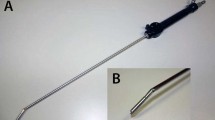Abstract
Background: Hemostasis is crucial during laparoscopic surgery. Unlike conventional electrosurgery, saline-enhanced electrosurgery (SEE) improves the electrode-to-tissue interface. This study investigated SEE as a means of achieving hemostasis in liver and splenic injuries and assessed the associated histologic changes. Methods: Nine anesthetized pigs underwent laparoscopic liver tip and splenic wedge amputations. Injuries were treated with SEE (25–35 and 35–45 W, respectively). Animals were sacrificed postprocedure and at 1 and 4 weeks. Depth of necrosis was analyzed using a mixed model analysis of variance. Results: Liver mean depth of necrosis was 5.3 mm (acute), 6.0 mm (1 week), and 5.3 mm (4 weeks) (p = not significant). Splenic mean depth of necrosis was 7.0 mm (acute), 7.0 mm (1 week), and 2.7 mm (4 weeks). (p < 0.01) Acute injuries demonstrated thermal coagulation necrosis that healed with well-defined bands of collagen at 1 and 4 weeks. Conclusions: SEE provides effective hemostasis and results in an acceptable depth of necrosis with satisfactory wound healing in a porcine model of solid organ injury.





Similar content being viewed by others
References
E Croce M Azzola R Russo M Golia S Angelini S Olmi (1994) ArticleTitleLaparoscopic liver tumour resection with the argon beam. Endosc Surg Allied Technol 2 186–188 Occurrence Handle1:STN:280:ByqD1MzpvFw%3D Occurrence Handle8000883
RD Dowling J Ochoa SA Yousem A Peitzman AO Udekwu (1991) ArticleTitleArgon beam coagulation is superior to conventional techniques in repair of splenic injury. J Trauma 31 717–721 Occurrence Handle1:STN:280:By6B3s3htl0%3D Occurrence Handle2030520
M Dujovny R Vas CP Osgood JC Marroon PJ Janetta (1975) ArticleTitleAutomatically irrigated bipolar forceps. J Neurosurg 43 502–503 Occurrence Handle1:STN:280:CSmD3cnptlQ%3D Occurrence Handle1159492
P Gale B Adeyemi K Ferrer A Ong AI Brill B Scoccia (1998) ArticleTitleHistologic characteristics of laparoscopic argon beam coagulation. J Am Assoc Gynecol Laparosc 5 19–22 Occurrence Handle1:STN:280:DyaK1c7itlSnsg%3D%3D Occurrence Handle9454871
PM Go GR Goodman EW Bruhn JG Hunter (1991) ArticleTitleThe argon beam coagulator provides rapid hemostasis of experimental hepatic and splenic hemorrhage in anticoagulated dogs. J Trauma 31 1294–1300 Occurrence Handle1:STN:280:By2D3MrktVY%3D Occurrence Handle1920562
S Kimel LO Svaasand M Hammer-Wilson MJ Schell TE Milner JS Nelson MW Beras (1994) ArticleTitleDifferential vascular response to laser photothermolysis. J Invest Dermatol 103 693–700 Occurrence Handle1:STN:280:ByqD2M3nsl0%3D Occurrence Handle7963659
T King R Worpole (1972) ArticleTitleSelf-irrigating bipolar diathermy forceps. J Neurosurg 37 246–247 Occurrence Handle1:STN:280:CS2B3sbkt1A%3D Occurrence Handle5046095
C Mann G Boccara V Grevy F Navarro JM Fabre P Colson (1997) ArticleTitleArgon pneumoperitoneum is more dangerous than CO2 pneumoperitoneum during venous gas emobolism. Anesth Analg 85 1367–1371 Occurrence Handle1:STN:280:DyaK1c%2FltV2ktA%3D%3D Occurrence Handle9390610
S Mordon T Desmettre JM Devoisselle V Mitchell (1997) ArticleTitleSelective laser photocoagulation of blood vessels in a hamster skin flap model using a specific ICG formulation. Lasers Surg Med 21 365–373 Occurrence Handle10.1002/(SICI)1096-9101(1997)21:4<365::AID-LSM8>3.0.CO;2-O Occurrence Handle1:STN:280:ByiH28blt1Y%3D Occurrence Handle9328984
T Takao M Nishida Y Maeda S Hiraki K Takao A Tangoku M Oka (1999) ArticleTitleEffect of cautery with irrigation forceps on the remnant liver after hepatectomy in rats. Eur Surg Res 31 173–179 Occurrence Handle10.1159/000008636 Occurrence Handle1:STN:280:DyaK1M3jsVSksQ%3D%3D Occurrence Handle10213856
P Gale B Adeyemi K Ferrer A Ong AI Brill B Scoccia (1998) ArticleTitle. J Am Assoc Gynecol Laparose 5 19–22 Occurrence Handle1:STN:280:DyaK1c7itlSnsg%3D%3D
Acknowledgements
We thank Ulla Wallin, Perry De Fazio, and Jeffery Pettit for their technical expertise and assistance with this project. This study was funded in part by TissueLink Medical (Dover, New Hamshire, USA)
Author information
Authors and Affiliations
Corresponding author
Rights and permissions
About this article
Cite this article
Sims, C., Stylopoulos, N., Clavijo, J. et al. Histologic characteristics of laparoscopic saline-enhanced electrosurgery of liver and splenic injuries . Surg Endosc 17, 1739–1743 (2003). https://doi.org/10.1007/s00464-002-8638-8
Received:
Accepted:
Published:
Issue Date:
DOI: https://doi.org/10.1007/s00464-002-8638-8




